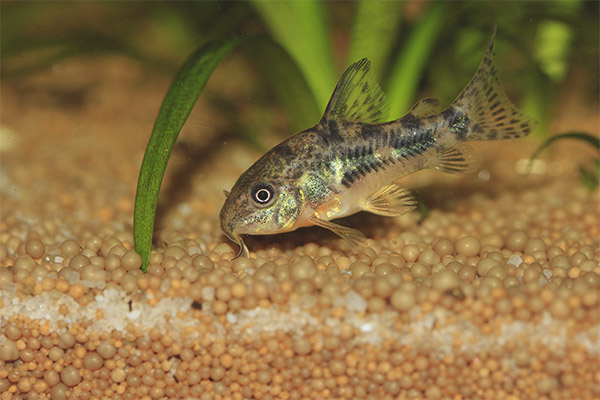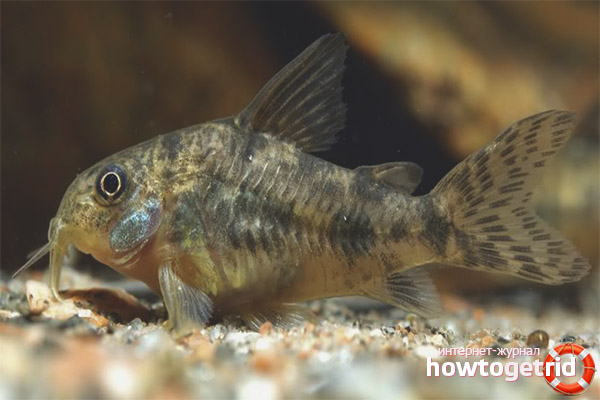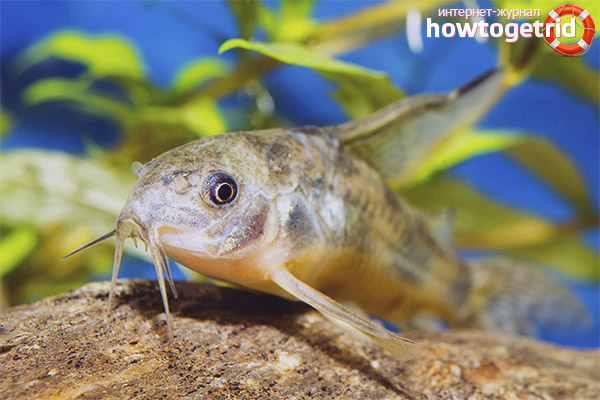The content of the article
Speckled soma got its name due to the fact that they have a specific color. These fish are otherwise referred to as straw shell, corridors, as well as ray-finned. Due to the fact that the represented family in a short time became popular among aquarists, soms were called simply ordinary. In terms of their habitat, these fish are listed in South America. In fact, they are harmless and peaceful. Quickly adapt to changes in the aquatic environment, easily divorced, do not require frills in the content.
Description
- The presented family is considered to be a direct competitor of the catfish, as well as the bronze corridor. Water dwellers are classified as small-sized, in their length they reach about 6 cm (males), and females 3-7 cm. Dirty brownish-greenish body, squat, with scattered strips of gray or green-blue.
- Every catfish is famous for its unique appearance. All individuals have specks of different size and shape, and their number varies.
- On the fins and back there are brownish spots, they are slightly paler. The abdominal area is colored gold. Males are famous for having a sharp fin on their backs, and for females it is rounded.
- As is characteristic of all conforming, on the top of the lips are the antennae. They help the fish to look for food, as well as get it out of the ground. Fins are equipped with spikes that do not allow predatory relatives to eat catfish. If transplantation is planned, then it is done not with a plastic but with a plastic container.
- Aquatic inhabitants from natural conditions are usually brighter colored than their relatives, grown in an aquarium. These fish prefer to be active at night, although with natural light they can also be found swimming.
- Usually kept in flocks of 8 individuals. As for the term of life, it is 6-15 years when it exists in the natural environment and 3-5 years in aquarium conditions. It all depends on what the temperature regime will be in the aquarium, as well as the acidic environment and hardness. The higher the temperature, the less live the fish.
- When the fish are in the spawning period or are afraid, they begin to actively move their fins. They make strange sounds like rustling or crunching.
- Catfish can breathe atmospheric air, protruding from the water surface. If the fish does this too often, you must install an appropriate aeration filter in the water tank.
- Gender is easily detected. For females, the abdominal region is round. When looking at the female from above, it seems wider than the male. Males are much brighter colored, they can boast a large fin on the back and pointed anal.
Content
- Difficulties in the care of these aquatic inhabitants will not arise even among beginners. The fish easily gets used to any aquatic environment, it gets on very well in the company of soobraznyhs.
- As neighbors can act kilfish, barbs, danios, tetras and dwarf-type cichlids, guppies, swordtails and neonchiki. Of the swordtails, preference is given to those who swim at the top or in the middle.
- The represented family feels great, not living in warm water.Therefore, they should not be hooked fishes that prefer tropical conditions. Catfish will not be able to get along with aggressive relatives, who constantly open the hunt.
- Catfish prefer to dwell in the valley. They need to cover the soft soil in the form of sand or small-caliber gravel stone. Catfish look better on a dark background. Be sure to plant in the tank plants, install snags, so that they act as light diffusers.
- Corridors do not need careful maintenance. All the rules for keeping similar somics apply to them. That is, the temperature regime adheres to the mark from 22 to 24 degrees, the rigidity is up to 7 units, the acidity is low (6 units).
- Since individuals are kept in flocks, they need a spacious tank. Usually, 7 l is given to catfish. water. This volume increases if more fish are added to the water housing. It is not enough to replace the liquid once a week, it needs to be done every 2-3 days. 20% of the volume is removed, new water is added.
- Soma can get sick for various reasons, ranging from the accumulation of food debris in the aquarium and their rotting, ending with the presence of salts and nitrites.If suddenly one of the fish is sick, remove it and transplant it into another tank until it is completely cured.
Feeding
- The family under discussion does not impose special requirements on the content and feeding in particular. They can eat granular, pelletized composition, as well as bloodworms or tubers.
- As the fish feed from the bottom, enough food should fall into this area. It is better to choose sinking flake food. Also suitable live or frozen product.
- If there are a lot of different fish in the aquarium, including those feeding from the water surface, then choose a different food. One should remain at the top, and the other should fall to the bottom of the catfish.
Compatibility
- The speckled catfish can be kept both in a small and large aquarium. But here it is necessary to take into account a small nuance. It is strongly recommended to keep such fish in flocks of at least 5 individuals. Barbusses, live beetles, danios, small tetras, kilfish, ramerezi and small cichlids are considered good neighbors for such catfish.
- Do not forget that the representatives of fish in question prefer cool water.For the same reason, it is necessary to treat the selection of neighbors with extreme caution.
- Do not even think about settling catfish along with heat-loving discus. In addition, the considered individuals should not be kept with aggressive large inhabitants of the aquatic world.
Breeding
- When catfish start spawning, then later about 200 eggs can be obtained from this. Each of them in diameter reaches 2 mm. Regarding the duration of incubation, it is 4-12 days. It all depends on the temperature and other conditions. As a spawning tank is selected with a volume of 12 liters. minimum.
- A couple of males are assigned to the female. In order for fish to begin breeding, it is necessary to repeat their natural biotope as much as possible and imitate the season of showers. That is, a third of the liquid is drained, a new, cool one is added instead. Aquarium is installed in the sun.
- Experts advise to feed the fish with artemia, moth, daphnia, and pipe maker. The female will be ready to spawn when her abdominal area turns red and the body itself is sealed. Then reproduction becomes possible.
- Reproduction can proceed in different ways.The male begins to play with the female, pawing her abdomen with a mustache. Then the male individual releases milt, the female swallows them and then passes through the intestinal tract. Caviar turns out. Spawning time is one hour or more.
- So that parents do not eat caviar, they must be deposited in another tank. Maturation takes place over 7 days, but it can happen earlier. It all depends on the temperature of the water.
- When the fry appear, they are fed with ground dry food (dust), crushed worms, Artemia. Be sure to change the water to the tank was always clean.
Health
- Fishes of the represented family are exposed to all the same diseases as other inhabitants. Since soma is freshwater, fungal and other bacterial infections usually develop in such conditions.
- If you notice that the water dweller has become sluggish, moves less, does not eat much, you should pay attention to the external data.
- Fins can be folded, whitish coating appears, the color will become dull. Then the animal is transplanted from the rest of the guests.
- If treatment is carried out in a timely manner, the catfish will quickly return to normal. However, one thing you need to remember for sure is that fish are not treated with salt water.
It is easy to care for this type of aquarium pets, if you follow all the recommendations and follow the basic rules of maintenance. Soma are freshwater inhabitants that will not survive in brackish water. They need to frequently replace the liquid, removing dirt. Do not forget about the saturation of the water space with oxygen.
Video: aquarium fish speckled catfish













To send